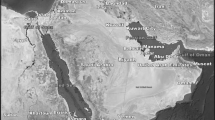Abstract
Ground water has increasingly taken its place in the provision of safe, potable supply in the developing world. Large investments have been made in infrastructural development for rural ground water supply schemes, but far too little attention has been given to assess the sustainability of these supplies. Overexploitation of aquifers, evident in failing boreholes and deteriorating water quality, has become a world-wide concern. Developments in physics half a century ago established the basis of isotope hydrology. Radioactive isotopes give information on ground water dynamics and recharge rates whilst non-radioactive - or stable - isotopes indicate origins of ground water and delineate ground water bodies. Environmental isotope hydrology is increasingly seen as a powerful discipline in assessing ground water systems. This is particularly important in developing environments, where historical data is rarely available. Brief examples are presented of isotope applications to collaborative ground water studies conducted at the University of the Witwatersrand. Recharge estimates based on isotope ‘snapshot’ data conform well with results from subsequent long-term water level observations in the Kalahari of Botswana. The importance is demonstrated of irrigation return flow and pollution hazard to the Lomagundi dolomite of Zimbabwe. Isotopes suggest the source of high nitrate concentrations to an important ground water supply in Tanzania. Mechanisms of the release of arsenic into millions of tube wells in Bangladesh are put into perspective. Isotope hydrology as appropriate technology is highlighted in terms of its cost-effectiveness and the investigative empowerment of local investigators.
Similar content being viewed by others
References
E. Braune, Towards comprehensive groundwater resource management in South Africa, in: Groundweater: Past Achievements and Future Challenges, Sililo et al. (Eds), Balkema, Rotterdam, 2000, 7.
W. F. Libby, Radiocarbon Dating, Univ. of Chicago Press, 1952.
W. F. Libby, Proc. Natl. Acad. Sci., 39 (1953) 245.
K. O. MÑnnich, Naturwissenschaften, 55 (1957) 158.
A. O. Nier, Rev. Sci. Instr., 18 (1947) 398.
H. C. Urey, J. Chem. Soc., (1947) 562.
World Water Vision, Making Water Everybody's Business, World Water Council, 2000.
B. Th. Verhagen, Palaeoecology of Africa, 21 (1990) 143.
B. Th. Verhagen, The isotope hydrology of the Karoo basin underlying the Kalahari Thirstland, Southern Africa Proc. Intern. Conf. on Groundwater in Large Sedimentary Basins, Perth, Australian Water Resources Council, Canberra, Conf. Series No. 20 (ISBN 0 644 14651 6) p. 390.
B. Th. Verhagen, Recharge quantification with radiocarbon: independent corroboration in three Karoo aquifer studies in Botswana, in: Isotope Techniques in Water Resources Development and Management, 1999, IAEA-CSP-2/C ISSN 1562-4153, IAEA, Vienna.
S. Sunguru, K. Froehlich, B. Th. Verhagen, W. Wagner, Geohydrology and isotope hydrology of the Lomagundi dolomite, Zimbabwe, in: Groundwater: Past Achievements and Future Challenges, Sililo et al. (Eds), Balkema, Rotterdam, 2000, p. 623.
B. Th. Verhagen, M. A. Geyh, K. Froehlich, K. Wirth, Isotope hydrological methods for the quantitative evaluation of ground water resources and semi-arid areas: Development of a Methodology, Research Reports of the Federal Ministry for Economic Cooperation of the Federal Republic of Germany, Bonn, ISBN 3-8039-0352-1, 1991, p. 164.
L. Kongola (Tanzania), personal communication.
BGS, Arsenic contamination of groundwater in Bangladesh, D. G. Kinniburgh, and P. L. Smedley (Eds), BGS Technical Report, WC/00/19, 2001.
Author information
Authors and Affiliations
Rights and permissions
About this article
Cite this article
Verhagen, B.T. Isotope hydrology and its impact in the developing world. Journal of Radioanalytical and Nuclear Chemistry 257, 17–26 (2003). https://doi.org/10.1023/A:1024724705499
Issue Date:
DOI: https://doi.org/10.1023/A:1024724705499




